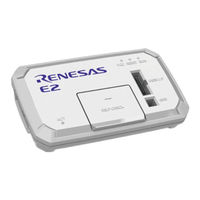User Manuals: Renesas RL78/G1H Microcontroller
Manuals and User Guides for Renesas RL78/G1H Microcontroller. We have 2 Renesas RL78/G1H Microcontroller manuals available for free PDF download: User Manual
Renesas RL78/G1H User Manual (941 pages)
16-Bit Single-Chip Microcontrollers
Brand: Renesas
|
Category: Microcontrollers
|
Size: 19 MB
Table of Contents
-
1 Outline
19 -
-
Memory Space54
-
-
-
-
-
8 Timer Rj
241 -
-
-
-
-
13 A/D Converter
298 -
-
-
UART (Uartq)343
-
-
-
-
-
-
Start Conditions468
-
Addresses469
-
Stop Condition471
-
Wait472
-
Canceling Wait474
-
15.5.15 Cautions487
-
-
Timing Charts517
-
-
Functions of DTC532
-
-
Vector Table538
-
DTC Operation547
-
Normal Mode549
-
Repeat Mode550
-
Chain Transfers552
-
Cautions for DTC553
-
-
-
Functions of ELC558
-
-
ELC Operation561
-
-
-
-
Pin Functions564
-
Digital Pin564
-
Analog Pin565
-
-
-
Digital Block566
-
Analog Block567
-
Oscillator Block568
-
-
-
Configuration569
-
Index571
-
-
-
Overview669
-
-
RF Mode673
-
-
-
25 Regulator
814 -
26 Option Byte
815 -
27 Flash Memory
825-
-
Port Pins829
-
-
Self-Programming836
-
Data Flash843
-
Advertisement
Renesas RL78/G1H User Manual (55 pages)
Brand: Renesas
|
Category: Computer Hardware
|
Size: 0 MB
Table of Contents
-
-
-
-
-
RESET# Pin25
-
TOOL0 Pin28
-
Gnd29
-
VDD29
-
-
-
Reset45
-
Flash Memory45
-
Gdidis46
-
-
Go to Here]48

